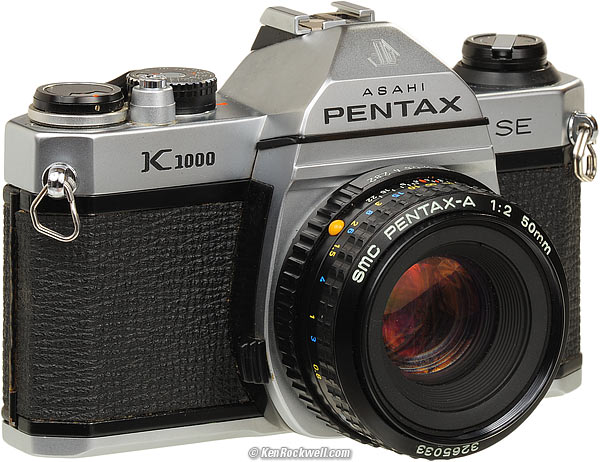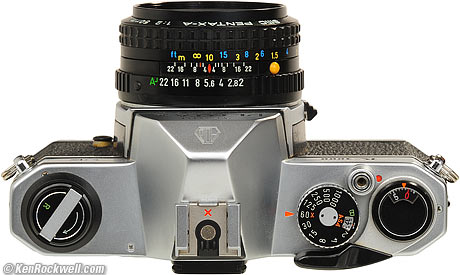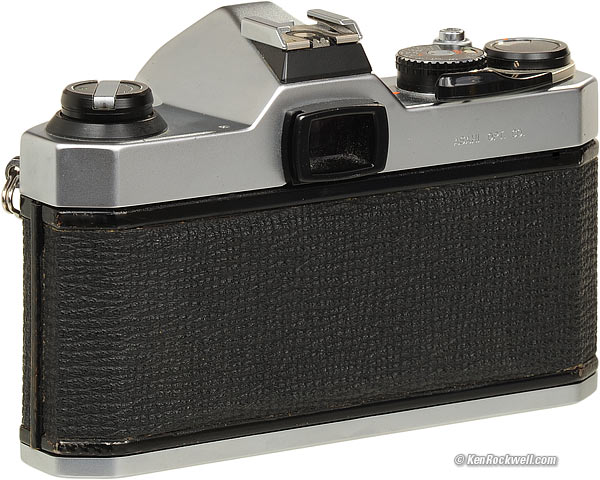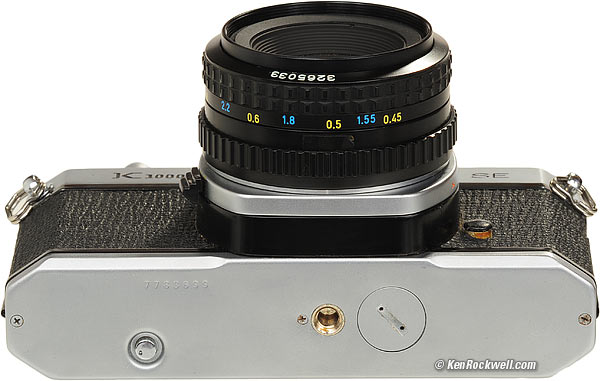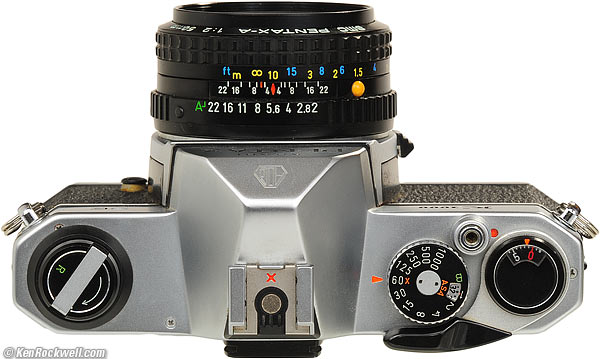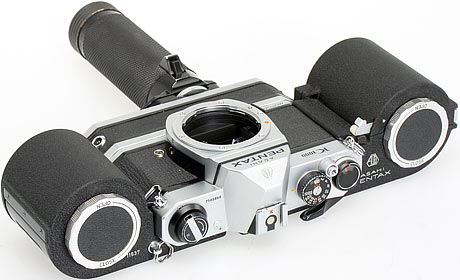Home Donate New Search Gallery Reviews How-To Books Links Workshops About Contact
Pentax K1000
35mm SLR (1976-1997)
© 2011 KenRockwell.com. All rights reserved.
Intro Specs Performance Compared Usage Recommendations
Pentax K1000 SE with SMC Pentax-A 50mm f/2 (22.2 oz./628g with battery, strap lugs and 36-exposure film but no caps or strap, about $60 used for body and lens). enlarge. This free website's biggest source of support is when you use these links, especially this link directly to them at eBay (see How to Win at eBay). It helps me keep reviewing these oldies when you get yours through these links, thanks! Ken.
October 2011 More Pentax Reviews Pentax Lenses All Reviews
Introduction top
Intro Specs Performance Compared Usage Recommendations
|
I use Adorama, Amazon, eBay, Ritz, B&H, Calumet, J&R and ScanCafe. I can't vouch for ads below.
|
The Pentax K1000 is one of photography's greatest, most popular and longest-lived cameras.
The Pentax K1000 is simple. It does exactly what it needs to do, and nothing more.
Exactly like Apple, simplicity is the K1000's greatest strength. All the irrelevant foolishness that chokes fancier cameras, and especially digital cameras, never gets in the way of a great picture with the K1000. While DSLR shooters are standing there cursing at their cameras when they can't figure out why it won't take the picture when they press the shutter, the K1000 just keeps shooting.
The Pentax K1000 is a 35mm SLR. It is completely mechanical and needs no battery to run, except for one tiny 20¢ A76 cell to run its light meter.
Unlike the "automated" digital nonsense with which too many people burden themselves, the K1000 has only three shooting controls: aperture, shutter speed and focus. (You also set the film speed when you load it.)
While digital cameras have automatic ISO, automatic white balance, automatic exposure, automatic advance, automatic focus and a zillion other "automatic" features, why on God's green Earth is it that then the"manual" K1000 lets us take great pictures with only three controls, while fully automatic cameras of today have hundreds of controls that ned to be set? Not only does the Pentax K1000 only have three controls, it even tells us exactly how to set each of these controls all by itself!
The Pentax K1000 is so brilliant that you never need to turn the meter or camera on or off: both are always on for instant picture taking!
While even the most brilliant cameras like LEICA's $8,000 M9-P still make us stop and do math in our heads to see Zone System values, the Pentax K1000's brilliant exposure meter has an in-finder zone-system indicator. The middle is Zone V, and up and down the scale are the other (unmarked) Zones. Easy. The K1000's shutter button is much smoother than any LEICA made since 2002, with none of the LEICA's notchiness that blurs long exposures.
Most 35mm cameras expect us to guess if their film is wound or not to the next frame. While LEICA, Nikon, Canon and other cameras demand that we remember this from day to day, the Pentax K1000 has a shutter-ready indicator right next to the shutter button. Orange (as shown) means ready, and black means not wound. Brilliant
There is a very good reason every photo teacher demanded the K1000 be used in their classes: because the K1000 is an extraordinary camera that forces you to think about your picture instead of your camera.
Pentax K1000 SE with SMC Pentax-A 50mm f/2. enlarge.
Specifications top
Intro Specs Performance Compared Usage Recommendations
Type
35mm Single-Lens Reflex.
Lenses
Pentax K mount.
Pentax screw-mount with adapter; manual diaphragm and stop-down metering.
Name
K1000, spotlighting the advanced 1/1,000 top shutter speed.
Features
Through-the-lens full-aperture metering.
Instant-return mirror.
Single 360º rotating shutter speed dial.
Full-aperture coupled metering.
ASA setting on shutter dial with automatic ASA lock.
Full-aperture viewing with fully automatic diaphragm (closes down to set shooting aperture and reopens to full aperture automatically for every shot).
Bright Fresnel focusing screen with microprism center spot (also additional split-image on K1000 SE).
"Pure Image" finder with no distractions except the meter/zone system needle.
Automatic double-exposure prevention.
Shutter-cocked indicator.
Combined shutter cock and film-wind lever.
Ratcheted multi-step wind lever. Many Nikons don't have this.
Automatic resetting frame counter.
Rewind crank with folding lever and rotating crank tip.
Ratcheted single or multi-stroke wind lever with comfortable plastic tip.
X-sync hot shoe.
PC flash sync socket.
Threaded for a conventional cable-release.
¼-20 tripod socket. Tripod Screw Maximum Depth: 5.5mm.
Finder
0.88x magnification with 50mm lens.
Glass prism.
Ground glass with central microprism spot.
The luxury K1000 SE version seen here has a combined split-image rangefinder with microprism collar.
Meter needle, and that's it.
Shutter
Horizontal rubberized-silk focal-plane.
1 ~ 1,000 and Bulb.
1/60 flash sync.
For flash bulbs, use 1/30 and slower with M, MF and FP bulbs.
Orange "cocked" indicator next to shutter button.
Uses a regular screw-in cable release.
Wind Lever
Single or ratcheted multiple strokes.
160º throw with 10º stand-off.
Frame counter goes to 37, starts at 00.
Rewind Time
11 seconds, manual crank.
Meter
Two CdS cells.
Single live needle in finder: center is OK, up is brighter and down is darker.
ASA 20 ~ ISO 3,200.
Metering range: EV 3 ~ EV 18 at ISO 100 with f/2 lens.
Power
One tiny 20¢ A76, LR44, SR44 or S76 cell.
Power Switch: None, just leave on the lens cap so the CdS cells sucks no power.
I measured 200 µA current draw with the needle centered, and 100 µA in the dark.
Size
3.7 x 5.6 x 1.9 inches HWD.
93.5 x 143 x 49.5 millimeters HWD.
Weight
Japan: with battery, strap lugs but no caps, strap or film: 21.375 oz. (606.0g).
Japan: with battery, strap lugs and 36-exposure film but no caps or strap: 22.155 oz. (628.1g).
China: with battery, strap lugs but no caps, strap or film: 18.567 oz. (526.4g).
China: with battery, strap lugs and 36-expoousure film but no caps or strap: 19.347 oz. (548.5g).
50/2 (Taiwan): 4.920 oz (139.4g).
Environmental
Temperature Range: -20ºC ~ 50ºC (may need re-lube at low temperatures).
Maximum Rate of Temperature Change: 20ºC per hour.
Missing
No self-timer.
No easy double-exposures.
No motor drive, except for this one.
No Autofocus
No auto exposure.
No easy depth-of-field preview (you can press the lens mount button and half-unmount the lens to preview depth of field.)
No mirror lock-up.
No intervalometer.
No custom functions.
No interchangeable focus screens.
No batteries (just one tiny cell).
No problem! None of that other stuff is important; the K1000 lets us pay attention to our picture instead of our camera's instruction book.
Pentax K1000 SE. enlarge.
Performance top
Intro Specs Performance Compared Usage Recommendations
The Pentax K1000 like a breath of fresh air. It just goes.
The biggest gotcha is that all of the samples I've tried to use have meters well out of calibration. Many of these meters are broken but still read; no single setting of the ASA dial will work accurately for all light values.
The best samples of K1000 I've gotten read consistently, but like most 35mm cameras, require a little testing to determine the best setting of the ASA (ISO) dial for any particular film.
Shutters usually work well, although the nice one here was 2/3 of a stop fast at 1/30 (1/30 is actually 19mS or 1/52).
The all-metal Made-in-Japan versions are the nicest. They say ASAHI PENTAX, with "AOCo" engraving on the prism.
The Hong Kong and Chinese versions use a lot more plastic and may have grindy film advance levers. These cheaper versions didn't say ASAHI on the prism.
The K1000 has moderate to low vibration (recoil) when fired.
There is a marked red tick at frame 36, and the counters stops at 36, even though there is a white tick at 37.
The shutter release is super smooth. There are no notches of kinks as have modern LEICAs.
Pentax K1000 SE. enlarge.
Compared top
Intro Specs Performance Compared Usage Recommendations
The Canon AE-1 Program is another favorite of mine. It requires a bigger and less common 6V 544 (4LR44) battery to operate and is more plasticy, but has a much more reliable exposure meter and fully automatic exposure.
The K1000 and AE-1 Program are amateur cameras, while the Nikon FM, Nikon FE, FE2, FM2 and FM3a are professional-level cameras. The Canon and Pentax of this era are not as tough, while these Nikons can cheerfully take a beating and keep on shooting.
The K1000 is simplicity incarnate, the AE-1 Program adds a better meter and automation, while the Nikon FE is as simple, while built much tougher with a far more accurate meter.
Want simple for the lowest price? Get a K1000 for $60 complete with lens.
Want automatic exposure and a better meter, but with a little more complexity and harder to find battery? Get a Canon AE-1 Program.
Want professional toughness and metering, but for more money? Get a Nikon.
The K1000 never asks you to move or think about a power switch, while the Canon and Nikon do.
It's much faster and easier to set the K1000's manual exposure than to play with other camera's menus.
It's much faster to turn the big focus ring than to dick with other camera's autofocus settings, and no matter what you do, the K1000 always fires when you press the shutter.
Usage top
Intro Specs Performance Compared Usage Recommendations
Pentax K1000 SE with SMC Pentax-A 50mm f/2. enlarge.
Read Pentax' K1000 User's Manual.
Battery Check: Set ISO 100 and BULB. If the needle is up, you're OK.
Before you go shooting, be sure to compare the K1000's meter to a good light meter. Feel free to use the meter in another camera, or use the Pocket Light Meter on your iPod.
With every 35mm camera, be sure to shoot some tests first before shooting something critical. Especially be sure to check the exposure, and set the ASA or ISO dial accordingly so the next roll will come out perfectly.
My particular sample seen here give the best results with its ASA dial set to ASA 32 for ISO 50 Velvia, and set to ASA 64 for ISO 100 film. Every camera is different; test yours, and set a lower ASA if your slides are too dark, and a higher number if they are too light.
The meter has a limited range and won't read if you set something crazy; for instance, with my ASA 50 film, the meter won't read at 1/1,000 of a second. No big deal, meter at 1/500 and change the aperture by a stop.
To use the Zone System, Zone V is the center of the meter needle range. The top and bottom of the "OK" area is ±½ stop. The top is Zone VIII and the bottom is Zone II.
There is no depth-of-field preview button, but you can press the lens-release button and half-unmount the lens to preview depth of field.
Double Exposures: Tighten the film slack with the rewind knob, press the rewind button, advance the film, and pray. Pentax suggests making a blank exposure on the next frame just in case.
Pentax K1000 with Motor Drive (custom). enlarge.
There was no production motor drive, however this one-of-a-kind camera turned up and is for sale at National Camera Exchange.
Recommendations top
Intro Specs Performance Compared Usage Recommendations
The K1000 is a great camera for shooting. Since it dispenses with all the baloney (it doesn't even need a power switch), most of us will be quite surprised at how pleasant it is to shoot.
Photography is all about our imagination and concentrating on the basics of what makes a great image, and never about our camera. The K1000 lets us pay attention to our photography.
More Information
The Pentax K1000 by Jason Schneider.
Help me help you top
I support my growing family through this website, as crazy as it might seem.
The biggest help is when you use any of these links to Adorama, Amazon, eBay, Ritz, Calumet, J&R and ScanCafe when you get anything, regardless of the country in which you live. It costs you nothing, and is this site's, and thus my family's, biggest source of support. These places have the best prices and service, which is why I've used them since before this website existed. I recommend them all personally.
If you find this page as helpful as a book you might have had to buy or a workshop you may have had to take, feel free to help me continue helping everyone.
If you've gotten your gear through one of my links or helped otherwise, you're family. It's great people like you who allow me to keep adding to this site full-time. Thanks!
If you haven't helped yet, please do, and consider helping me with a gift of $5.00.
As this page is copyrighted and formally registered, it is unlawful to make copies, especially in the form of printouts for personal use. If you wish to make a printout for personal use, you are granted one-time permission only if you PayPal me $5.00 per printout or part thereof. Thank you!
Thanks for reading!
Mr. & Mrs. Ken Rockwell, Ryan and Katie.
Home Donate New Search Gallery Reviews How-To Books Links Workshops About Contact
